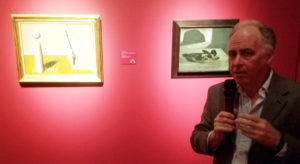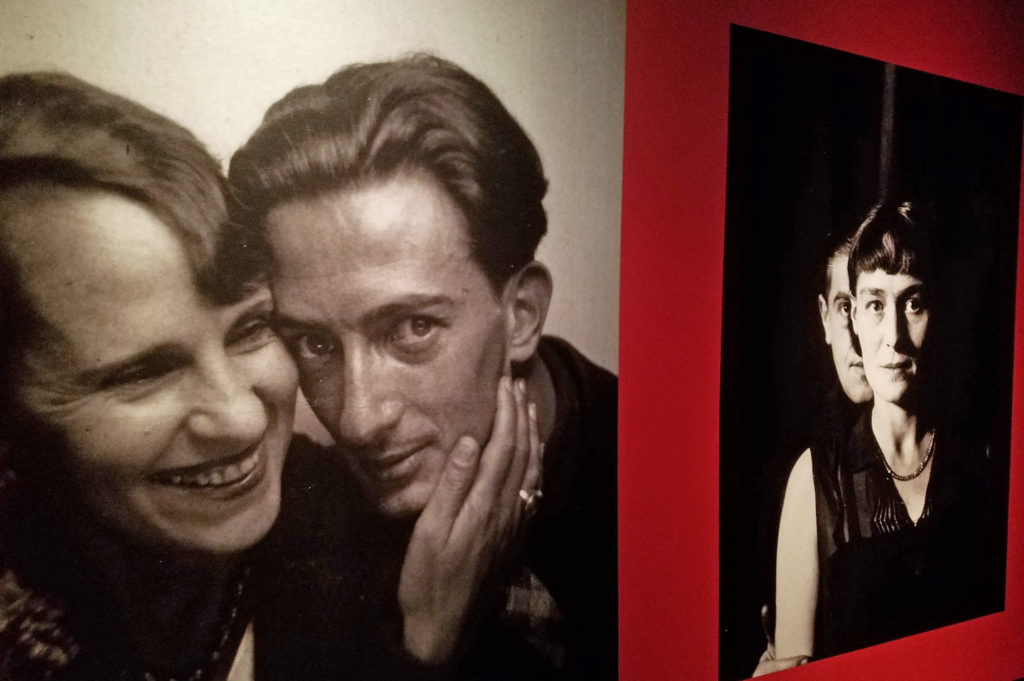Create
‘Magritte & Dali’: A challenge to perceptions

The third-floor exhibition space of the Dali Museum has never felt more like a hall of funhouse mirrors. A new show pairing the works of Dali with those of the Belgian artist Rene Magritte – the two most celebrated Surrealists in history – turns reality on its painted, freakishly disproportioned ear.
Opening Saturday, Dec. 15, Magritte & Dali is the latest in the museum’s ongoing series of creative “matches.” At a media preview Thursday morning, Chief Curator William Jeffett pointed out the similarities in the two artists’ perception-challenging work, particularly in the late 1920s (when they met and became friends during Paris’ golden age) through the early ‘40s.

Curator William Jeffett talks Magritte. Photo by Bill DeYoung.
“They both had careers that were a little bit longer than the scope of the exhibition, so the idea is to focus on the period where there was the most connection between them,” he explained.
With all previous Dali “doubles,” Jeffett added, “we’re trying to find things where’s there’s a strong connection and not a gratuitous one. If we’re doing pairings, the idea is to do it with some justification.”
Their styles, thought processes and use of bizarre and sometimes unsettling imagery veered wildly apart over the decades. In Magritte & Dali, Jeffett – working in tandem with the Royal Museums of Fine Arts of Belgium – focuses on both artists’ use of shadows, the appearance of three dimensions, their approach to nudes, animals that morph into human figures, the insertion of painted words and digits and other similarities.
Often, there was a deeper meaning.
“These two artists share a strategy,” said Dali Executive Director Hank Hine, “by convincingly portraying the world as it appears, but then showing some flaw. Something that doesn’t work. Some crack in the surface.
“They let you know that the world is not as it appears. They let you know that you can question the ordinary, and know that there’s an extraordinary world beyond it.”
Said Jeffet: “There were lots of interesting dialogues going on between them, and we tried to show some of the rapports through a series of concepts, such as the idea of looking into something, or looking through something.”

Getting into the picture. Photo by Bill DeYoung.
Magritte’s most well-known work, “The Son of Man,” is not part of the Dali exhibition. It does, however, make an appearance. Via an “augmented reality portal” created by St. Pete-based Pixel Rain Digital, visitors can literally “walk into” the painting – the bowler hat and the face-masking apple are floating in space, waiting. Once you’re happy with the way you appear, you can make image freeze for eight seconds – long enough to take a Surrealism selfie.
Visitors don’t materialize inside the digital paintings – there’s a Dali version, too – until they stand squarely on a marked spot on the floor. It’s like being in a Star Trek transporter room.
One suspects Magritte and Dali would have liked the effect.
Also a challenge to our definition of the real world is the “Cloud Room,” another Pixel Rain creation. All four walls of this large space are covered with fluffy white clouds floating through a blue sky. The floor and ceiling are similarly cloud-draped.
But these clouds are not painted. They are digital, they are three-dimensional, and they are moving, liquid, drifting slowly against the surrounding and all-encompassing Magritte sky.
It’s as confounding – and as strangely intoxicating – as the collected paintings of these two masters. With Salvador Dali and Rene Magritte, Jeffet said, “There’s always a sense of odd scale and the enigmatic.”

Both artists’ wives were their muses. Left: Salvador and Gala Dali; right: Rene and Georgette Magritte.







